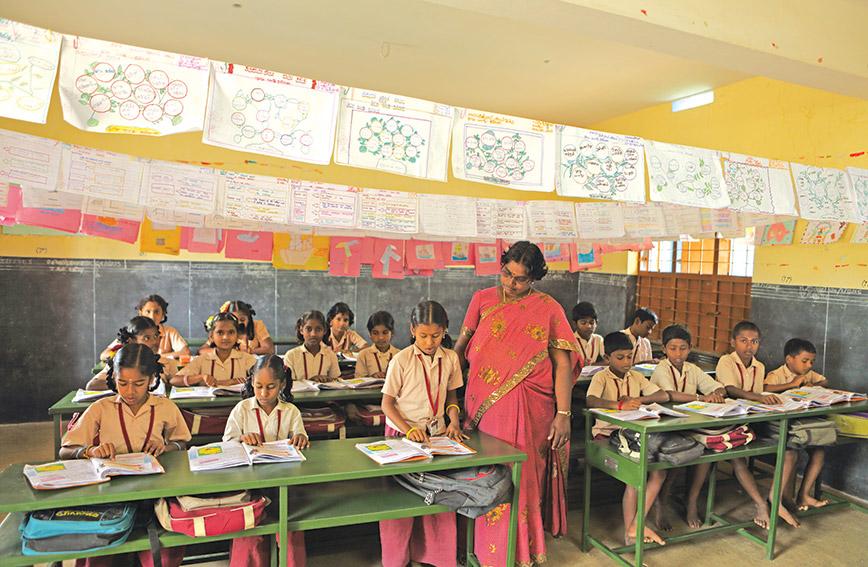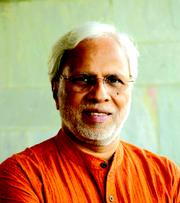

DILEEP RANJEKAR
The winter’s afternoon in a Rajasthan school was special for us since we were to spend time with the Bal Sabha (Children’s Parliament). Its members were excited to present to us the structure, design and scope of the Bal Sabha. The children appeared to be bright and engaged with the school's processes.
After they left, an invigorating discussion followed with the teachers on several issues regarding society, education and teachers’ experiences in the school. Almost all the teachers appeared to be engaged and enjoying what they were doing. Among other issues, we also discussed their views on corporal punishment. At a principle level, all teachers agreed that usage of threat or intimidation of any kind is detrimental to the learning process. We were happy about this conviction. When we were about to leave, a lady teacher asked me, “How do we discipline the children if we don’t punish them?” In her mind, the only way to discipline children was by punishing them. It is very reflective of what a large section of teachers struggle with while thinking about disciplining children.
The belief that punishment is necessary for children is very widespread and deeply entrenched in society, including parents. About seven years ago, many parents were apprehensive about sending their children to Azim Premji Foundation schools because our teachers did not punish children. Parents asked, what kind of a school is this that does not beat children? Today, one of the key reasons why parents want to send their children to our schools is the absence of punishment.
While many beliefs about children and the process of education have changed, both teachers and parents almost regularly resort to punishing or threatening children in order to “make them obey the norms” set by them. The threats and intimidation manifest in several forms ranging from shouting, abusing, humiliating, beating, caning, pinching, pulling ears, making the child stand outside the class or on the bench or making children hold their toes or throwing chalk pieces/dusters at them. Some teachers use extremely cruel and painful methods such as deeply pinching the arms (where it hurts the most).
Punishment of a severe nature can leave permanent scars on the mind of the child. In 2007, a large group of ex-students of my own school assembled on the school premises exactly 40 years after passing out. While a small section of them decided to felicitate four of our teachers, many amongst us opposed it and boycotted the function, recalling the severe punishment meted out by these teachers. Forty long years had not been able to erase those memories.
The Right to Education (RTE) Act of 2009 prohibits corporal punishment in schools. However, the Act applies only to children from six to 14 years old. Further, the National Policy for Children of 2013 specifically provides that the State shall “ensure no child is subjected to any physical punishment or mental harassment” and requires the State to “promote positive engagement to provide children with a good learning experience”. Several subsequent court decisions have prohibited any physical or mental punishment.
One of the stated roles of education in the National Policy of Education is to further the goals of secularism, socialism and democracy. This needs the process of education to be interactive, participative and democratic. Thus, anything that creates a feeling of oppression, force and compulsion has no place in education.
Why do teachers and parents still resort to punishment as a means to discipline a child? There are several explanations. Teachers often perceive that punishment yields immediate results, it solves an immediate problem, it brings immediate order out of chaos, and it establishes control. The second reason — more insidious and often part of our psychological DNA — is the way we see power as something to be used to subdue someone weaker, to ensure obedience. The third is our cultural bias of fear being necessary for learning — our own personal experiences reinforce this.
The fourth and a crucial one is that teachers don’t know the alternatives! The teacher education in our country does not prepare them to deal with children who may not follow the norms. If you are not professionally competent you either use the traditional methods or allow your emotions to take over and do what your anger guides you to do.
We forget how helpless a child feels against the power of teachers and parents and how wrong it is to oppress the child with such power. Through punishment, we often legitimise violence and reinforce the arbitrary use of power. This very act is against establishing democracy in the process of education. It prevents the realisation of the free potential of the child. The child gets a clear message: “You can do it because you are bigger and more powerful than the child.”
What are some of the possible solutions?
l Universally develop an understanding among teachers and parents that every child is capable of learning and children learn best when they are respected, valued and involved in the process.
l View discipline as something that enables/encourages performance through commitment, rather than merely maintaining order or conformity with set norms. The focus should be on self-regulation and self-discipline.
l Build a stimulating school and classroom culture, and evolve norms that are applicable to all – teachers and students. Develop the same among parents.
l Develop the belief during teacher education that the process of teaching and learning is all about developing a comfortable and enabling relationship between the teacher and student. There is no place for fear and apprehension in this relationship.
l Treat making mistakes in the classroom as part of learning; students should not be ridiculed or reprimanded for them. Help students see that with additional effort they can overcome learning difficulties. Believe that students can change learning habits and behaviour with guidance.
l Do not belittle students when academic goals are not achieved. Do not compare individuals or groups of students with each other in terms of how quickly or well they learn new material. This can be most stressful and is worse than direct corporal punishment. Do not discriminate on the basis of academic or socio-economic status of a student.
l Use the daily school assembly effectively to bring critical issues to a platform where they can be openly and without fear, discussed by all. This will create a culture of openness leading to lack of stress.
Do not judge students on the basis of their behaviour but analyse the reasons behind their behaviour and discuss it with them with sensitivity and care.
l Avoid outbursts of anger, harsh disciplinary methods, raised voices and insensitive comments as these only alienate students. Instead, rely on firm, consistent instructions to convey messages to the class. Explain non-negotiables to students clearly — talk about why they are non-negotiables.
l Facilitate and teach conflict resolution within the classroom. Encourage students to discuss and generate ideas about how to effectively solve the problem, thus enabling them to take responsibility for the situation and develop the skill of negotiation.
We owe it to our future generations to help them become constituents of a society that believes in an environment that is open, rational, caring and, above all, free of fear.
Dileep Ranjekar is CEO of the Azim Premji Foundation
Comments
Currently there are no Comments. Be first to write a comment!



